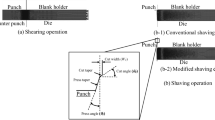Abstract
Shear cutting induces high strains and work hardening into the shear-affected zone, thus reducing the formability of the sheet metal material during subsequent forming operations. A common method for increasing the residual formability of shear-cut component edges is to shave the surfaces. The shaving process allows for the removal of highly hardened areas from a pre-cut contour, resulting in a comparatively high residual formability of the cutting surface. However, as known from conventional cutting, a burr remains on the shear surface when shaving. Such burr formation is undesirable and therefore usually has to be removed afterward. For this reason, a new process has been developed which combines two processes within the same stroke of punch, the counter-cutting, and shaving process, enabling the production of burr-free shear surfaces showing a high portion of clean-cut proportions and significantly 1.6 times higher hole expansion ratios than conventional cutting surfaces. The present paper deals with numerical and experimental investigations carried out in the course of the process development with the high-strength sheet metal material DP600.
Access this chapter
Tax calculation will be finalised at checkout
Purchases are for personal use only
Similar content being viewed by others
References
Gall M, Liewald M (2013) Experimental investigation of the influence of shear cutting parameters on the edge crack sensitivity of dual phase steels. IDDRG, Zurich, pp 219–224
Wu X, Bahmanpour H, Schmid K (2012) Characterization of mechanically sheard edges of dual phase steels, Elsevier Verlag
Matsuno T, Sato K, Okamoto R, Mizumura M, Suehiro M (2016) Synergy effect of shear angle and anisotropic material ductility on hole-expansion ratio of high-strength steels. J Mater Process Technol
Kühlewein R (2003) Einfluss der Prozessparameter auf das Nachscheiden schergeschnittener Konturen, Dissertation, TU München
Gläsner T, Volk W, Hoffmann H, Golle R (2015) Evaluation eines Verfahrens zur Bestimmung der Kantenrisssensitivität von hochfesten Stählen, utfscience, Verlag Meisenbach
Liebing H, Lange K (1978) Erzeugung gratfreier Schnittflächen durch Aufteilen des Schneidvorgangs (Konterschneiden), Dissertation, Universität Stuttgart
Sachnik P, Volk W (2017) Methodik für gratfreie Schnittflächen beim Scherschneiden, Disseration, TU München
Lange K (1990) Umformtechnik – Handbuch für Industrie und Wissenschaft, Band 3: Blechbearbeitung, 2. völlig neu bearbeitete und erweiterte Auflage; Springer Verlag
Erlenmeier W (2010) Stanzwerkzeug und Verfahren zum mehrstufigen Stanzen. Europa-Patent EP 2198988:A1
Haack J (1993) Patentschrift: Process for producing burr-free workpieces by blanking, in particular in a counterblanking tool, US Patent No 5247862 A
Haack J (1994) Method for manufacture of workpieces by punching, in particular in a precision counter punching tool. Europa Patent No: EP 0418779:B1
Kappes J (2010) Schnittgratfreies Scherschneiden mittels Konterschneiden, utfscience, Universität Stuttgart
Wörz C, Gall M (2013) Grat- und flitterfreie Aluminiumbleche aus dem Stanzautomaten, MaschinenMarkt
Hoffmann H, Neugebauer R, Spur G (2012) Handbuch Umformen. Carl Hanser Verlag, München
Guidi A (1965) Nachschneiden und Feinschneiden. Carl Hanser Verlag, München
Romanowski WP (1965) Handbuch der Stanzereitechnik. VEB-Verlag, Berlin
Weckener H (1975) Werkzeugstähle für Schnittwerkzeuge unter Berücksichtigung der verschiedenen Schneidverfahren, Technischer Bericht
Gläsner T, Sunderkötter C, Hoffmann M, Volk W, Hoffmann H, Golle R (2013) Zweistufiges Scherschneiden reduziert die Kantenrissempfindlichkeit, Meisenbach Verlag GmbH
Mackensen A (2013) Presswerkorientierte Analyse der Umform- und Scherschneideigenschaften von Mehrphasenstählen, Dissertation, TU München
Nothaft K (2013) Scherschneiden höchstfester Blechwerkstoffe im offenen Schnitt, Dissertation, TU München
Held C, Schleich R, Sindel M, Liewald M (2009) Untersuchung zum Einfluss der Verfestigung von schergeschnittenen Kanten auf folgende Umformpro-zesse, UTFscience.de
Gläsner T, Sunderkötter C, Rommel S, Volk W (2015) Evaluation eines Verfahrens zur Bestimmung der Kantenrisssensitivität von hochfesten Stählen, umformtechnik.net, Meisenbach Verlag GmbH
ISO 16630:2009(E), Metallic materials – Sheet and strip – Hole expanding test, 2009
Sadagopan S, Urban D (2003) Formability Characterization of a New Generation of High-Strength Steels, AISI/DOE Technology Roadmap Program, Final Report, American Iron and Steel Institute
Schneider M, Eggers U (2011) Investigation on punched edge formability, IDDRG 2011, Salzgitter
Atzema E et al (2012) A European round robin test for the hole expansion test according to ISO 16630
Senn S, Liewald M (2019) Numerical investigation on a new process of combined counter- trimming with regard to improvement of the residual formability of burr-free shear-cut edges, NUMIFORM 2019. Portsmouth, USA
Author information
Authors and Affiliations
Corresponding author
Editor information
Editors and Affiliations
Rights and permissions
Copyright information
© 2021 The Minerals, Metals & Materials Society
About this paper
Cite this paper
Senn, S., Liewald, M. (2021). A New Approach for the Production of Burr-Free Sheet Metal Components Having Significantly Increased Residual Formability. In: Daehn, G., Cao, J., Kinsey, B., Tekkaya, E., Vivek, A., Yoshida, Y. (eds) Forming the Future. The Minerals, Metals & Materials Series. Springer, Cham. https://doi.org/10.1007/978-3-030-75381-8_232
Download citation
DOI: https://doi.org/10.1007/978-3-030-75381-8_232
Published:
Publisher Name: Springer, Cham
Print ISBN: 978-3-030-75380-1
Online ISBN: 978-3-030-75381-8
eBook Packages: Chemistry and Materials ScienceChemistry and Material Science (R0)




